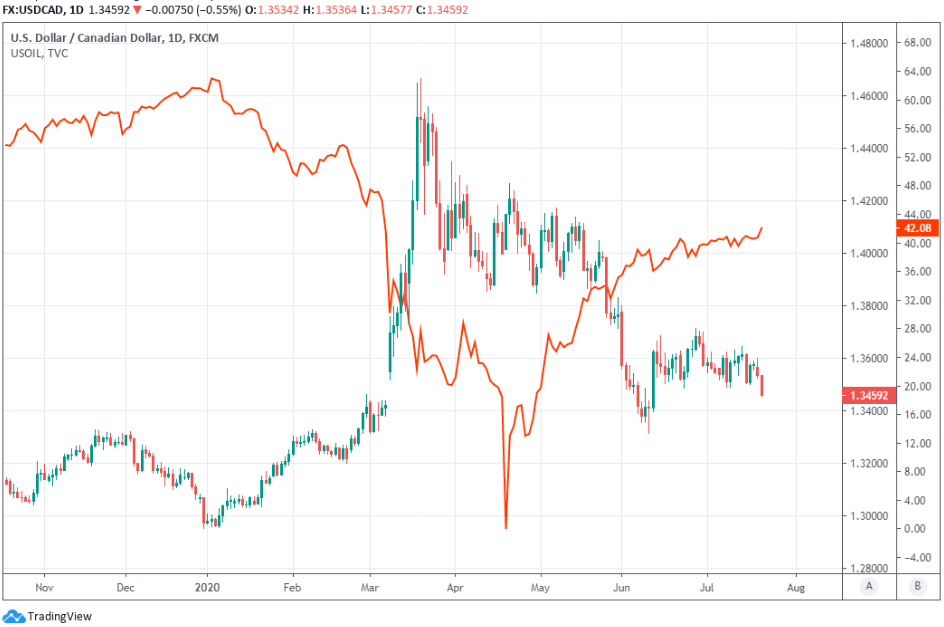Canadian Dollar Quibbles with Retail Sales Miss but Still Enjoys Oil and Risk Tailwinds
- Written by: James Skinner
-

Image © Adobe Images
Achieve up to 3-5% more currency for your money transfers. Beat your bank's rate by using a specialist FX provider: find out how.
The Canadian Dollar faltered at session highs Tuesday after May retail sales recovered less than was anticipated by the market, although the Loonie retained the support of rallying oil prices and robust investor risk appetite.
Canadian Dollars were bought widely Tuesday though the upturn stalled when Statistics Canada said retail sales rose 18.7% in May, which came as a disappointment for a consensus that was looking for a 20.2% increase.
"Motor vehicle and parts dealers led the growth, followed by an increase in sales in almost all other subsectors. Although sales increased in May, retail sales remain 20.0% below February levels," Statistics Canada says, before noting that around 23% of retailers were still closed in May.
Core retail sales, which ignore spending on large ticket items like motor vehicles because of the distorting impact they have on underlying trends, rose by a much lesser 10.6% when markets were hoping to see an 11.9% rebound.
"Sales are still being buoyed by the enormous government income-support programs and consumers satisfying pent-up demand, both of which could fade in the second half," says Royce Mendes at CIBC Economics.
Retail sales in volume terms, which is what matters most in the calculation of GDP, were up by a lesser 17.8% in May after having fallen -24.1% in April. However, Statistics Canada said Tuesday that its preliminary estimates suggest sales rose a further 24.5% in June.
Above: USD/CAD shown at 15-minute intervals alongside Pound-to-Canadian Dollar rate (orange line).
"Initial data over May and June, including retail and home resale numbers, continued to point to a quicker-than-expected initial rebound in activity early in the economic recovery. This initial rebound was likely fueled by substantial government income support measures, and there is still a risk that those measures expire before labour markets are fully recovered," says Claire Fan, an economist at RBC Economics. "We continue to expect a sharper than expected initial rebound to be followed by more moderate growth beyond June."
Markets care about the data because retail sales are a large portion of household spending which itself accounts for a substantial share of GDP.
The extent to which sales are rebounding provides insights into the strength of the immediate recovery out of the crater carved into the economy by the coronavirus and containment efforts.
Relative economic recovery rates could be an important influence on currencies going forward because at a minimum, economies that recover faster will do less damage to national finances and could facilitate a quicker normalisation of central monetary bank monetary policies.
The Bank of Canada has cut its cash rate to 0.25% this yer and began quantitative easing in the hope of supporting the economy by crushing borrowing costs for government, companies and households, although this has reduced the Canadian Dollar's relative yield advantage.
Above: USD/CAD shown at daily intervals alongside WTI crude oil futures (orange line).
"Our card data point to a similar-sized headline increase in June that would leave retail sales approaching year-ago levels," says Daria Parkhomenko, a strategist at RBC Capital Markets. "Technically, a daily close below key quadruple bottom support at 1.3505 would indicate that a short-term top has formed for USD/CAD."
The USD/CAD rate arrested earlier declines following the retail data but remained comfortably below the 1.3505 threshold flagged by RBC's Parkhomenko as being key to whether the charts advocate for more range-trading a break higher by the Canadian Dollar.
A daily close below 1.3505 for USD/CAD would open the door for a move down to 1.3357, Parkhomenko says, which would place a heavy burden on GBP/USD to prevent the Pound-to-Canadian Dollar rate from falling further.
GBP/CAD fell from 1.7160 to trade as low as 1.7080 on Tuesday but would be at risk of slipping back to 1.6965 if USD/CAD hits the 1.3357 level flagged as a possibility by RBC. GBP/USD would need to overcome the 200-day moving-average at 1.2701 it was testing Tuesday to prevent that from happening.
Above: Pound-to-Canadian Dollar rate shown at daily intervals with 21, 55 (red) and 200-day (green) moving-average.
"The positive global risk mood has lifted the CAD through the 1.35 level against the USD, with a healthy gain for WTI prices aiding and abetting the CAD’s rise," says Shaun Osborne, chief FX strategist at Scotiabank. "A closing break under 1.3510 will add to negative USD momentum in the short run at least. There is no major support points below the marker ahead of the early June low at 1.3316."
Sterling risks trading in a stiflingly narrow 1.6986-to-1.7162 range against its Canadian counterpart this week although an update from Brexit negotiators is due on either Thursday or Friday and any hint of progress in the talks could encourage a move above the top of that range.
Progress in the Brexit negotiations could drive GBP/CAD up to 1.7424, with scope for 1.8078 to be seen subsequently if such progress coincides with weakness in the Canadian Dollar that's observed through a rise in USD/CAD.
"GBP appears to have convincingly parted ways with the 1.2650 resistance mark—that will now stand as solid support—with today’s leg higher stalling just as it ran into its 200-day MA at 1.2704 that will act as the key mark to beat for the GBP to break out of its recent trading range. After the 1.27 area the pound faces no obvious resistance points aside from the 1.28 level (intraday high of 1.2813 on Jun 10) on the way to the 1.30 handle," Osborne says.
Above: GBP/USD rate shown at daily intervals with 200-day moving average in green and CAD/USD rate in orange.









